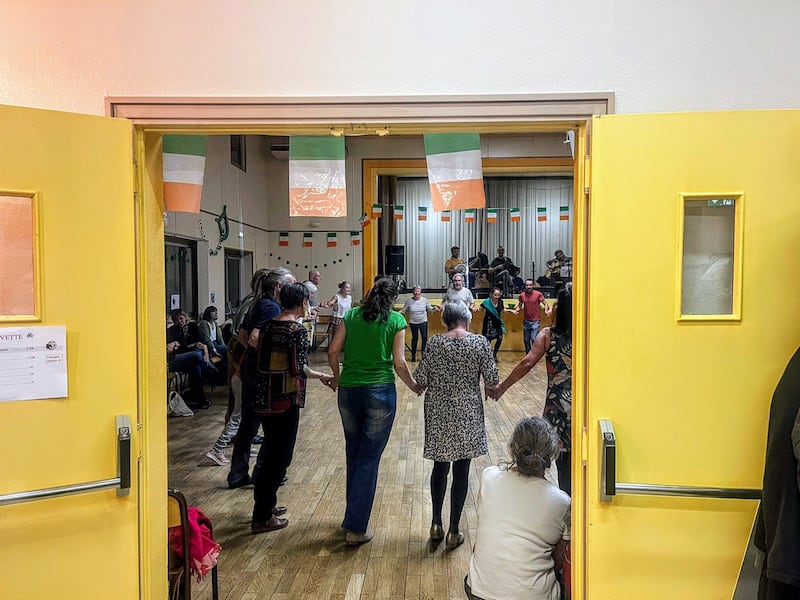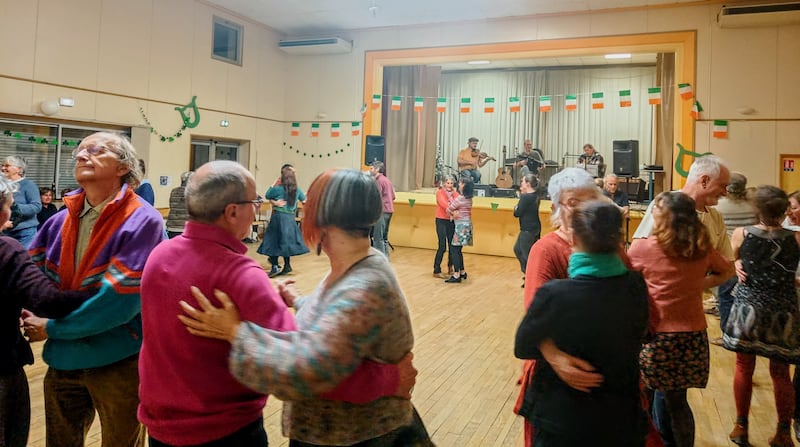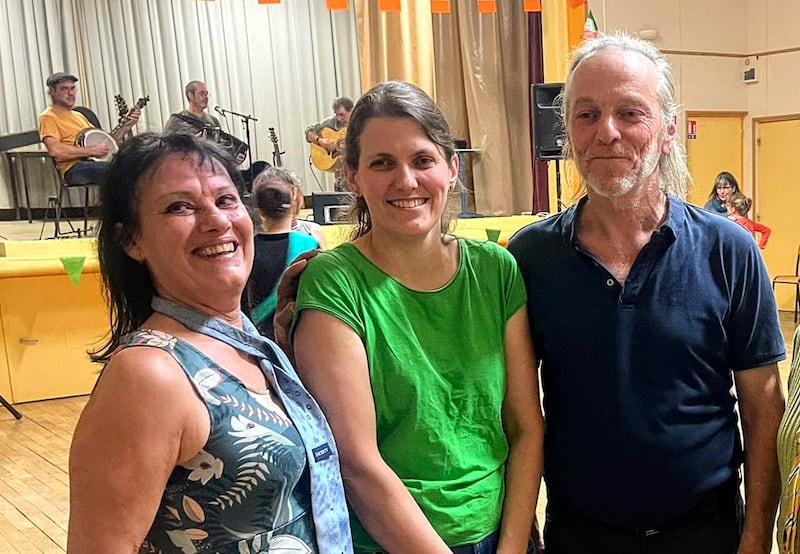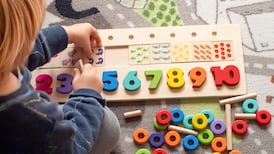The local hall is kitted out with Irish flags and the familiar sound of a jig begins, echoing on the wooden floor. A ring of 12 men and women dutifully start shuffling in and out as a kind but firm instructor watches on. It’s a scene encountered countless times across Ireland’s community centres, primary schools and pubs.
Except this time there is a slight difference. Shouts of “a haon, a dó, a trí” are instead replaced by “un, deux, trois”.
Welcome to the Irish dancing club of Préty in eastern rural France.
The charming village is so small it doesn’t even have a boulangerie, which is basically sacrilegious in the country. While lacking in baked goods, one thing it does have is a thriving Irish dancing community.
READ MORE
With 35 signed-up members, about six per cent of the town’s population is part of Les Amis de l’Irlande 71 (Friends of Ireland), the association that runs Irish dancing classes three times a month in the village.
“Irish dancing is a central part of my life really,” says Agnès Sergent, who is on the association’s committee. “Many of us need a routine in life and this gives us one.”
She’s chatting while hanging up Irish flag bunting in the town’s community centre. It’s the afternoon of St Brigid’s Day and the centre is abuzz with activity. A few members of Les Amis de l’Irlande 71 are setting up the hall for the big céilí taking place that evening to celebrate Imbolc. It’s an annual tradition in Préty, with St Brigid’s Day chosen “because St Patrick’s Day is already too busy”. In the background an Irish dancing class is taking place for beginners.

The three-hour lesson has just got going and the teacher, Delphine Alaguette, is explaining that for the next dance the group will need to start skipping.
“We’re not all so young, Delphine,” one of the older students quips.
The music starts. There are more women than men, so Delphine hops around to put a tie on three of them to signify their newfound masculinity for the purpose of the dance.
It’s hard work for the exclusively French group, many of whom are in their 60s and 70s, but progress is being made.
“I love doing this because people enjoy themselves and have a smile on their face,” Delphine says after the class.
The French woman’s passion for Irish dancing and culture began on her first visit to Ireland in 2000. She came across a trad session in a pub and fell for its sound and energy. She also fell in love with the welcome she received.
[ We have a quality of life that simply wouldn’t be possible at our age in IrelandOpens in new window ]
“In France we say we visit Ireland the first time for the country itself, but we come back for the Irish people because they’re so welcoming and kind,” she says.
Enamoured of the experience, she began playing trad music herself and now plays the bodhrán, tin whistle, low whistle and harp. A few years later she met Yvonne Donnellan-Tatre, an Irish woman who lived in the area, at an Irish music event and they got chatting.
Yvonne came up with the idea of an association to promote Irish culture and forge links with France, et voilà – in 2014, Les Amis de l’Irlande 71 was founded. While Yvonne moved from the area five years ago, the association has gone from strength to strength.
Irish dancing has been the key to this success. The classes were a joint idea between the two women. Delphine didn’t know much about Irish dancing at the beginning but began teaching herself with videos on YouTube.
“I watched what the guy in the video was doing, I wrote it down, and then I explained it in the workshops,” Delphine recalls. “So we started like that with a few people, and then little by little we were a bit more, and it’s already been 11 years!”
While Les Amis de l’Irlande 71 might seem an unusual concept, it’s not the only such organisation in France. There are several more Irish dancing groups dotted across the country in less populated areas such as Bourgogne-Franche-Comté and Chambéry, as well as in bigger cities such as Paris. The members often share events and go to dances together.
As Rencontres Musicales Irlandaises de Tocane, a group which organises an Irish music festival every July, put it in a recent social media post: “The Irish music scene is very rich and well-developed in France. There are many musicians in the four corners of France, associations, collectives and music groups who are passionate about Irish music.”

While Irish dancing and music are central to groups such as Les Amis de l’Irlande 71, the cultural bond between Ireland and France is only one aspect of a growing relationship.
Since Brexit, the French have been Ireland’s nearest EU neighbour and the two have found common ground in areas such as fishing, energy and agriculture. France is also among the most popular destinations for Irish students studying abroad on the Erasmus programme.
And it’s not just in music that Ireland’s cultural influence can be seen. Many French cities are home to GAA clubs, and the Fédération des Sports Gaéliques, established in 2004, now has 25 clubs under its umbrella.
The growing political and cultural ties are underlined by the opening of an Irish consulate in Lyon in 2022.
Back in Préty, night has fallen and the hall is filling up for the annual St Brigid’s Day céilí. The association welcomes all levels and the novices mix with the more experienced in a mishmash of styles and abilities.
It’s surreal to be in this small French town’s community centre surrounded only by French speakers as a live band (a trio of French men) blasts traditional Irish music around the room and dancers grab hands, with Irish flags in the background. The atmosphere is joyful, and even after an exhausting three-hour lesson earlier in the afternoon some of the older women are glued to the dance floor.


Many attendees are keen to chat about their love for Ireland, while others have no connection to the country and just got involved in the club as they liked the music and enjoyed the activities.
During a break from the dancing, Émilie Renebon, the club’s secretary, reveals what she thinks the biggest difference is between the Irish and the French.
“We were visiting Ireland and looking at how to get to Dublin Airport, but we couldn’t find it,” she says. “We asked these construction workers for directions, and they got into their truck for us to follow them. I said to myself, ‘No one in France is going to leave their job to take the time to do that,’ but they did it for us at 5am – it was extraordinary. In France, we’ll tell you the directions, but we’re not going to show you the way like they did.”
Agnès Sergent is equally enthusiastic about Ireland. She started Irish dancing in 2015 through the association and “became addicted”. Her first visit to Ireland was on one of Les Amis de l’Irlande 71’s regular trips to the country.
It may be fitting for a group of Irish dancers from an unexpected place, that their destination was also somewhat surprising – Castletown in Co Laois. Not ones to miss out on a jig, they heard there was an Irish dancing festival happening so they came along. Agnès had been learning for only six months at the time, and she picked up a lot from the other dancers. “The Irish are truly warm and very friendly,” she says. “It’s a really special atmosphere, I felt a real joy. And when you dance there it’s very special.”
Her passion for Irish dancing has brought her to places beyond Ireland, as she’s travelled to Italy and the Czech Republic where there are also associations.
It’s a similar story for Audrey Mallard. She began to learn Irish step dancing in Lyon 10 years ago then continued practising at another Irish dancing association when she lived in Switzerland.
The evening is beginning to wind down and slowly people drift away from the dance floor.
Perhaps Audrey sums it up best before she departs. “My heart has a connection with Ireland,” she says. And after an evening at a Préty céilí, you wouldn’t doubt her.
















